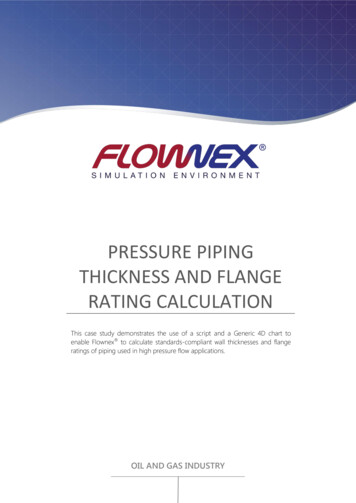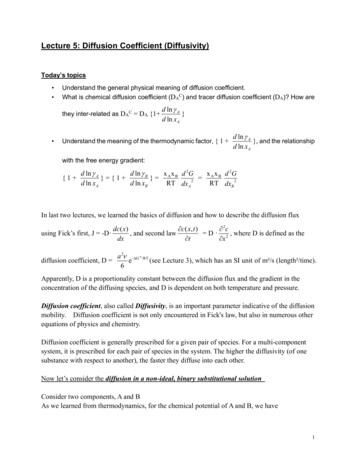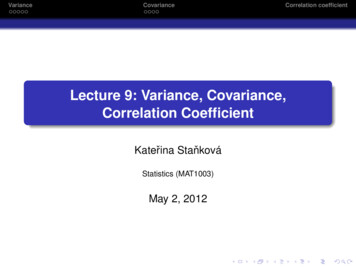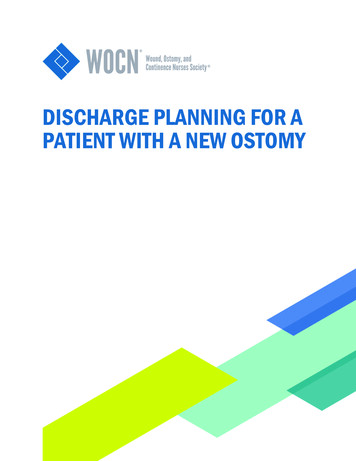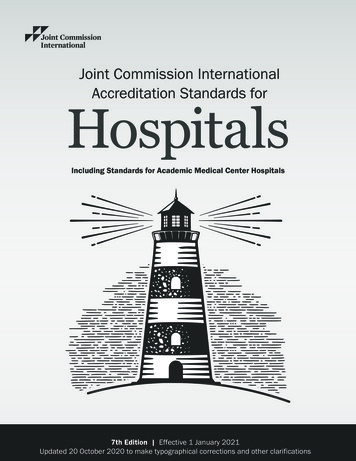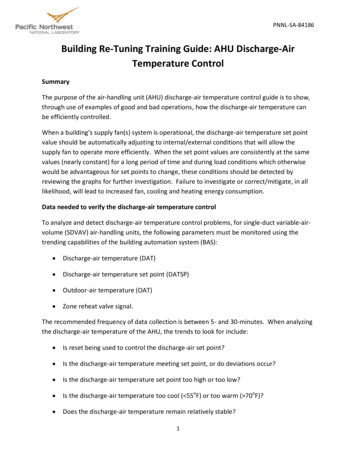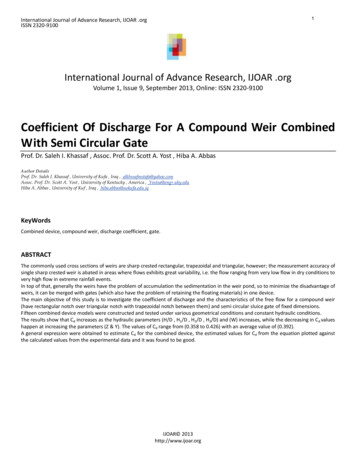
Transcription
1International Journal of Advance Research, IJOAR .orgISSN 2320-9100International Journal of Advance Research, IJOAR .orgVolume 1, Issue 9, September 2013, Online: ISSN 2320-9100Coefficient Of Discharge For A Compound Weir CombinedWith Semi Circular GateProf. Dr. Saleh I. Khassaf , Assoc. Prof. Dr. Scott A. Yost , Hiba A. AbbasA uthor DetailsProf. Dr. Saleh I. Khassaf , University of Kufa , Iraq , alkhssafmstafa@yahoo.comAssoc. Prof. Dr. Scott A. Yost , University of Kentucky , America , Yostsa@engr.uky.eduHiba A. Abbas , University of Kuf , Iraq , hiba.abbas@uokufa.edu.iqKeyWordsCombined device, compound weir, discharge coefficient, gate.ABSTRACTThe commonly used cross sections of weirs are sharp crested rectangular, trapezoidal and triangular, however; the measurement accuracy ofsingle sharp crested weir is abated in areas where flows exhibits great variability, i.e. the flow ranging from very low flow in dry conditions tovery high flow in extreme rainfall events.In top of that, generally the weirs have the problem of accumulation the sedimentation in the weir pond, so to minimize the disadvantage ofweirs, it can be merged with gates (which also have the problem of retaining the floating materials) in one device.The main objective of this study is to investigate the coefficient of discharge and the characteristics of the free flow for a compound weir(have rectangular notch over triangular notch with trapezoidal notch between them) and semi circular sluice gate of fixed dimensions.Fifteen combined device models were constructed and tested under various geometrical conditions and constant hydraulic conditions.The results show that Cd increases as the hydraulic parameters (H/D , H1/D , H2/D , H3/D) and (W) increases, while the decreasing in Cd valueshappen at increasing the parameters (Z & Y). The values of Cd range from (0.358 to 0.426) with an average value of (0.392).A general expression were obtained to estimate Cd for the combined device, the estimated values for Cd from the equation plotted againstthe calculated values from the experimental data and it was found to be good.IJOAR 2013http://www.ijoar.org
2International Journal of Advance Research, IJOAR .orgISSN 2320-91001 IntroductionAccurate flow measurement is very important for proper and equitable distribution of water among water users .The structures used for flow measurement should be accurate , economical and easy to use , installation , operation and maintenance . There aredifferent types of structures available for flow measurements , but the most common and important structures are weirs and sluice gates [1].One of weirs demerits is they need to be cleaned of sediments and trash periodically , regarding to gates , they retained the floating materials, so tominimize the disadvantage of weirs and gates , they can be combined together in one device , so that water could pass over the weir and below thesluice gate simultaneously .The flow through combined devices may be free when both the flow over weir and below the gate are free , and it is termed submerged when theflow below the gate is submerged (the flow over the weir may or may not be submerged) [2].Works dealing with the combined overflow and underflow as discharge measurement devices are available in (Escade 1938) , (Charles 1956) and(Chow 1959) , (Ahmed 1985) and (Naudascher 1991) as reported in [3].Muller (1944) studied the scour due to combined flow and derived a formula for estimating the scour depth downstream the combined devices dueto different ratios of overflows discharge to underflow discharge .Majcherek (1984) mentioned the idea of simultaneous flow over the weir and under the gate as reported in [2].In (1996) , Al-Hamid et al. [4] investigated a combined device models consisting of sharp crested rectangular contracted weir and an inverted triangular weir, they concluded that the channel bed slope has negligible effect on the discharge variation through the combined system and the angle oftriangular gate has significant effect on the combined discharge and the bigger the angle, the larger the discharge resulted, also one equation wasobtained from the experimental investigations that is suitable for both horizontal and sloping channel bed under submerged or free flow.Fadil (1997) developed a meter for the combined flow through contracted sluice gate and weir [5].Samani and Mazaheri (2007) presented a new physically based approach for estimating the stage discharge relationship of combined flow over theweir and under the gate for semi submerged and fully submerged conditions [6].Hayawi et al. (2008) studied the characteristics of the combined flow over a triangular weir with different angles and below a rectangular gate andproposed an equation for predicting the discharge coefficient through it.Sobeih et al. (2012) [7] investigated the influence of using openings in weirs on scour hole depth downstream of structure, this study was based onan experimental program included 171 runs.Recently , Ismail (2012) [8] investigated the characteristics of the combined flow over sharp crested trapezoidal weir and below rectangular sluicegate and studied the effect of the hydraulic and geometrical parameters on the coefficient of discharge and introduced two equations to evaluate it.In this paper, an experimental program using a combination of the compound weir (have rectangular notch over triangular notch with trapezoidalnotch between them) and semi circular sluice gate has been done to investigate the coefficient of discharge for the combined device and the characteristics of the combined free flow that passes through it and a generalized equation from the experimental investigations was obtained, thisequation include all the important variables.2 Theoretical analysisFig. (1) shows definition sketch for the combined free flow over a sharp crested compound weir and below a semi circular gate .a- Cross Sectionb- Longitudinal SectionFig. (1) : Definition Sketch For the Combined Hydraulic Measuring DeviceQtheo is the total free combined theoretical discharge through the combined device which is calculated as follows :Qtheo Qwtheo QgtheoWhere :Qwtheo : theoretical discharge over the compound weir .Qgtheo : theoretical discharge through the gate .IJOAR 2013http://www.ijoar.org(1)
3INTERNATIONAL JOURNAL OF ADVANCE RESEARCH , IJOAR .ORGISSN 2320-9100Qwtheo 8/15 (2g)½ tan (H35/2 - H25/2) (2g)½ W1 H1 (2g)½ W (H2 - H1 ) (8/15) (2g)½ tan 1 (H25/2 - H15/2)Qgtheo D2 (2gH)½Where :g : the gravitational acceleration .Q : the triangular weir angle .H : total head .Q1 : the angle of the crest of the compound weir .H1 , H2 , H3 : height of water above the first , second and third notches of the compound weir .W1 : width of first notch of the compound weir .W : width of second and third notch of the compound weir .D : the diameter of the gate opening .The actual total discharge can be predict as follows :Qact Cd QtheoWhere :Qact : total free combined actual discharge .Cd : coefficient of discharge for the combined device .Qact Cd [8/15 (2g)½ tan (H35/2 - H25/2) (2g)½ W1 H1 (2g)½ W (H2 - H1 ) (8/15) (2g)½ tan 1 (H25/2 - H15/2) D2 (2gH)½ ]The discharge (Qact) can be expressed by the following non dimensional relationship :Qact (H , H1 , H2 , H3 , Z , Y , D , B , W1 , W , X , S , g , , , )Where :Z : height of the second notch of the compound weir .Y : the distance between the lower edge of weir crest and the gate top .B : width of the flume .X : height of the crest .S : slope of bed flume . : density of the water . : dynamic viscosity . : surface tension .Based on equation (6) and by using Buckingham - theorem , the following function obtains :½ 2.5Qact ̸ g H (H/D , H1/D , H2/D , H3/D , Z/D , W/B , Y/D , Re , We)The effect of Reynolds number and Weber number is assumed to be negligible for the combined device except at very low head .(2)(3)(4)(5)(6)(7)3 Experimental set- upExperiments on the combined device were carried out in a glass fiber molded in stainless steel stiffeners sided flume and the bed of the flume madeof stainless steel plates. The flume is 18.6 m long with cross section (0.5 m wide by 0.5 m depth). The water depths were measured by two movablepoint gages having accuracy up to 0.1 mm and mounted on two carriages that can move to any position above the working section (15 m).Theactual discharge entering the combined device was measured by a pre calibrated V-notch weir installed at the outlet of the inlet tank. The inlet tankconnected with pipes to underground reservoir which supply water to the tank by centrifugal pump. The is equipped with a tail gate mounted at theend of the flume to control and adjust flow depths . All the experiments were conducted in the Hydraulic Laboratory of Al Najaf Technical Institute –Civil Techniques Department. Fig. (2) shows the flume that used to conduct the experiments.Fig. (2) : The flume that used to conduct the experimentsIJOAR 2013http://www.ijoar.org
4INTERNATIONAL JOURNAL OF ADVANCE RESEARCH , IJOAR .ORGISSN 2320-9100Fifteen models with different geometries combination were tested. Details of the tested models are given in table (1). The models were fabricatedof 3 mm Plexiglas sheet with all interior edges beveled to 2 mm thickness. The models were fixed to the flume at the middle using support fromdownstream side having the same shape of the model but with large dimensions and made from stainless steel plate (10 mm thick) stuck to theflume side walls using silicon rubber to ensure no leakage from the sides of the models.Table (1): Details of Tested Combined DeviceModel no.123456789101112131415W1 (cm)181818181818181818181818181818W (cm)666666666999111111Y (cm)691169116911999999Z (cm)66699911111169116911D (cm)131313131313131313131313131313D/2 (cm)6.56.56.56.56.56.56.56.56.56.56.56.56.56.56.5X (cm)1111111111111114 Analysis of Results4.1 Variation of Cd with the hydraulic parametersThe effect of the hydraulic parameters (H/D , H1/D , H2/D , H3/D) on the Cd are shown in figures (3) , (4) , (5) , (6) . From these figures , it can be concluded that the values of coefficient of discharge Cd (which can be obtained from equation (4)) increases as the hydraulic parameters increase atconstant values for (Z/D , W/B & Y/D) .Fig. (3) : The effect of (H/D) on CdIJOAR 2013http://www.ijoar.org
5INTERNATIONAL JOURNAL OF ADVANCE RESEARCH , IJOAR .ORGISSN 2320-9100Fig. (4) : The effect of (H1/D) on CdFig. (5) : The effect of (H2/D) on CdFig. (6) : The effect of (H3/D) on CdIJOAR 2013http://www.ijoar.org
6INTERNATIONAL JOURNAL OF ADVANCE RESEARCH , IJOAR .ORGISSN 2320-91004.2 Variation of Cd with Z/DThe influence of the third notch height (Z) on the Cd value has been investigated by using three different heights for (Z) (6 , 9 , 11) cm for specificdistance between the lower edge of weir crest and the gate top (Y) as shown in figures (7) & (8) . From the figures , it is clear that when the value of(Z) increases then the value of Cd decreases .Fig. (7) : The effect of (Z)on Cd with Y/D 0.462Fig. (8) : The effect of (Z)on Cd with Y/D 0.6924.3 Variation of Cd with W/BThe influence of the third notch width (W) on the Cd value has been studied by using three different widths for (W) (6 , 9 , 11) cm for constant crestheight (X 1 cm) as shown in Fig. (9), this figure clarify that for constant value of (X) and with increasing the value of (W) then the value of Cd alsoincreases.Fig. (9) : The effect of (W) on Cd with constant value of X 1 cm4.4 Variation of Cd with Y/DThe distance (Y) has been studied by using nine models and change the value of (Y) three times (6 , 9 , 11) cm for different values for (Z) (6 , 9 , 11)cm and the other geometric parameters are kept constant. Figures (10) , (11) , (12) show that for the same value of (Z) and increasing the value of(Y) causes decreasing in the value of Cd.Fig. (10) : The effect of (Y)on Cd with Z/D 0.462Fig. (11) : The effect of (Y)on Cd with Z/D 0.692IJOAR 2013http://www.ijoar.org
7INTERNATIONAL JOURNAL OF ADVANCE RESEARCH , IJOAR .ORGISSN 2320-9100Fig. (12) : The effect of (Y) on Cd with Z/D 0.8464.5 Development a new formulaA general non dimensional equation for predicting the coefficient of discharge for the combined device can therefore be written as :Cd C1*(H/D) C2*(H1/D) C3*(H2/D) C4*(H3/D) C5*(Z/D) C6*(W/B) C7*(Y/D)By using the computer package (STATISTICA) (multiple linear regression), the values of the constants C1 to C7 are found :C1 0.752C2 - 0.096C3 0.112C4 -0.717C5 -0.075C6 0.255C7 -0.823Then equation (8) become :Cd 0.752*(H/D) - 0.096*(H1/D) 0.112*(H2/D) – 0.717*(H3/D) – 0.075*(Z/D) 0.255*(W/B) – 0.823*(Y/D)R2 0.97Where : R2 : the coefficient of determination.(8)(9)4.6Variation of experimentally observed values of Cd and predicted values by equation (9) is shown in Fig. (13) , which shows a good agreement .Fig. (13) : Relationship between calculated and observed values of CdIJOAR 2013http://www.ijoar.org
8INTERNATIONAL JOURNAL OF ADVANCE RESEARCH , IJOAR .ORGISSN 2320-91005 ConclusionsBased on the analysis of experimental study on the free flow through the combined hydraulic measuring device, the following conclusions arewithdrawn:1- At increasing the hydraulic parameters (H/D , H1/D , H2/D ,H3/D), then the coefficient of discharge Cd increase as well, and the values of Cd rangefrom (0.358 to 0.426) with an average value (0.392).2- For the same distance between the lower edge of weir crest and the gate top (Y), the coefficient of discharge decreasing Cd at increasing (Z).3- As the width of the third notch of the compound weir (W) increasing for constant value of crest height (X), then the coefficient of discharge alsoincreasing.4- The coefficient of discharge decreasing with increasing the distance between the lower edge of weir crest and gate top (Y).5- Non dimensional equation (9) were applied to estimate the coefficient of discharge Cd in relationship include the parameters (H/D , H1/D , H2/D ,H3/D , Z/D , W/B , Y/D) and agreed well with the experimental data.6 List Of NotationsB : Width of the flume (L) .Cd : Coefficient of discharge ( - ) .D : The diameter of the gate opening (L) .g : The gravitational acceleration (LT-2) .H : Total head (L) .H1 , H2 , H3 : height of water above the first , second and third notches of the compound weir (L) .Q : The triangular weir angle ( - ) .Q1 : The angle of the crest ( - ) .Qact : free combined actual discharge (L3T-1) .Qgtheo : Theoretical discharge through the gate (L3T-1) .Qtheo : free combined theoretical discharge (L3T-1) .Qwtheo : Theoretical discharge over the compound weir (L3T-1) .Re : Reynolds's number ( - ) .S : Slope of bed flume ( - ) .W : Width of the second and the third step of the compound weir (L) .W1 : Width of the first step of the compound weir (L) .We : Weber number ( - ) .X : Height of the crest (L) .Y : The distance between the lower edge of weir crest and the gate top (L) .Z : Height of the second step of the compound weir (L) . : Dynamic viscosity (ML-1T-1) . : Density of the water (ML-3) . : Surface tension (MT-2) .References[1][2][3][4][5][6][7][8]Piratheep an , M. , Winston , N . E. F. , Pathirana , K. P. P. , (2006) , " Discharge Measu rem ent in Op en Channels Using Com p ou nd Sharp CrestedWeirs " , Jou rnal of the Institu tion of Engineers , Sri Lanka , Engineer – Vol. XXXX , N o. 03 , pp . 31 – 38Mahbou beh , S. , N asser , T. , Dehghani , A. A. , Abd ou l Rasou l , T. , Reza , R. G. , (2011) , " Exp erim ental Investigation o f the Effect of Contractionthon Scou ring in Dow nstream of Com bined Flow Over Weirs and Below Gates " , 5 SASTech , Khavaran H igher – ed u cation Institu te , Mashhad ,IranN egm , A. M. , Al-Brahim , A. M. , Al-H am id , A. A. , (2002) , " Com bined Free Flow O ver Weirs and Below Gates " , Jou rnal of H yd rau lic Research ,Vol. 40 , N o. 3 , p p . 359 – 365Al-H am id , A. A. , H u sain , D. , N egm , A. M. , (1996) , " Discharge Equ ation For Sim u ltaneou s Flow Over Rectangu lar Weirs and Below InvertedTriangu lar Weirs " , Arab Gu lf J. Scient. Res. , 14 (3) , pp . 595 – 607H ayaw i , H . A. M. , Yahia , A. A. G. , H ayaw i , G. A. M. , (2008) , " Free Com bined Flow Over a Triangu lar Weir and Und er Rec tangu lar Gate " , Dam ascu s Univ. Jou rnal , Vol. 24 , N o. 1Dehghani , A. A. , Bashiri , H . , Dehghani , N . , (2010) , " Dow nstream Scou r of Com bined Flow Over Weirs and Below Gates " , River Flow – Dittrich , Koll , Aberle & Geisenhainer (ed s)Sobeih , M . F. , H elal , E. Y. , N assralla , T. H . , Abd elaziz , A. A. , (2012) , " Scou r Dep th Dow nstream Weir With Op enings " , International Jou rnal ofCivil and Stru ctu ral Engineering , Vol. 3 , N o. 1 , p p . 259 – 270Ism ail , M. H . , (2012) , " Exp erim ental Investigation For Flow Throu gh Com bined Stru ctu re Weir and Gate " , Thesis Su bm itted to the College OfEngineering , Ku fa UniversityIJOAR 2013http://www.ijoar.org
racteristics of the combined free flow that passes through it and a generalized equation from the experimental investigations was obtained, this equation include all the important variables. 2 Theoretical analysis Fig. (1) shows definition sketch for the combined free flow over a sharp crested




